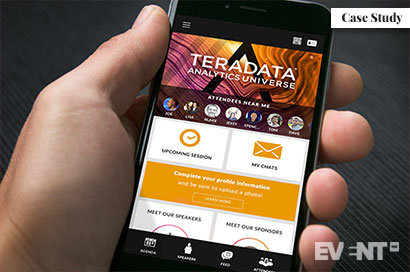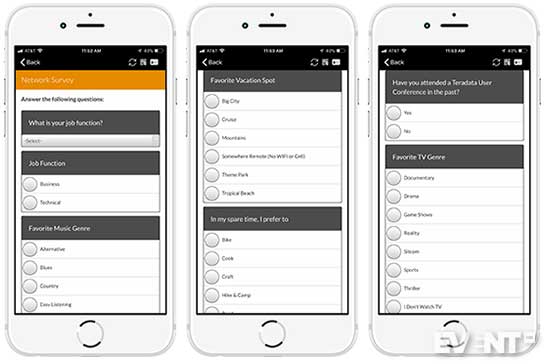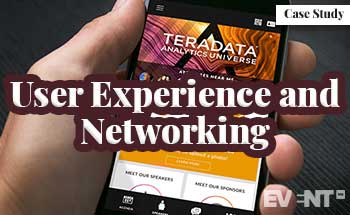

The planners behind Teradata Analytics Universe 2018 found out how aligning your event goals with the right technology can yield amazing results.
The Event
Teradata Analytics Universe 2018 is a next-generation analytics conference that attracts the most brilliant minds in the Teradata Analytics Universe- customers, partners, experts, and thought leaders. Together, they explore and solve global challenges for better outcomes for all.
QUICK FACTS ABOUT THE EVENT
- Held at Mandalay Bay in Las Vegas from October 13 to 2018
- 3,000+ attendees from over 45 countries
- 200+ sessions
- Attendees representing 900+ companies
- Ongoing event since 1985
THE OBJECTIVES
There were three objectives for the 2018 Teradata Analytics Universe Event in Las Vegas:
-
Produce a cohesive, world-class event app to harvest attendee data in order to personalize event offerings, support event goals, and be reflective of Teradata’s reputation as a leader in data intelligence.
-
Create meaningful networking and exhibitor interaction opportunities for their 3,000+ attendees and exhibitors.
-
Increase app adoption and usage. They had used an app at previous conferences but felt it was merely an e-agenda. For this conference, they were looking for something more deeply integrated into the event.
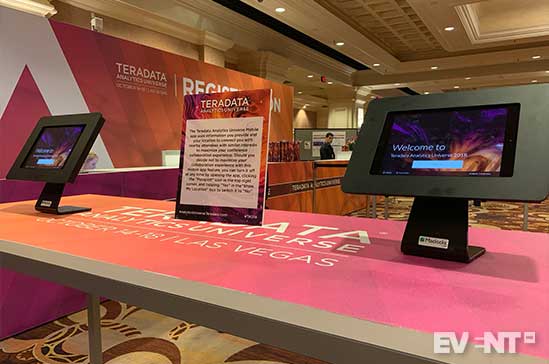

THE CHALLENGES
Designing an app for the world’s leader in pervasive data intelligence means the bar is set very high. Teradata was looking for an organization that understood its need for collecting data and applying it to outcomes within the conference, ultimately developing unique opportunities for attendees.
The initial challenges they faced are common to event planners and app technology:
The app is too much work.
Attendees come to the Teradata Analytics Universe event for learning, education, and networking. However, in the past, attendees did not engage in networking as expected. Upon analysis, it was decided it was likely due to the fact that there were too many separate actions taken outside the app. Attendees didn’t understand it and it felt like a lot of work.
Repeat technology isn’t comforting, it’s boring.
Attendees who had attended in years past wanted fresh, new opportunities. They were getting tired of the same-old gamification activities.
The audience was beyond the technology used.
Knowing the audience’s preferences and comfort with technology helps tech selection and adoption. Teradata is a vibrant brand with knowledgeable and tech-savvy attendees. In the past, the technology came across as a little sterile and stilted. It was missing the customized component that improves adoption.
How Were the Objectives Achieved?
Again, Teradata wanted three things:
- A world-class event app with engaging features
- More meaningful networking and exhibitor interaction
- Increased app adoption and usage
They achieved all three through four features and activities:
ATTENDEE MATCHMAKING
Networking is a major interest and desire of Teradata’s over 3,000 attendees. With a number of people that large, making meaningful introductions can be difficult. It could have been overwhelming for attendees to find new connections. MeetingPlay used a matchmaking algorithm to present each attendee with their top 50 matches to help narrow down the possibilities into something manageable.
MeetingPlay facilitated this through:
Administering an attendee questionnaire
Pairing matches based on several criteria
Creating a Top 50 Best List for each attendee
Employing tech to make the actual networking more efficient and fun
Attendees completed a networking questionnaire, which included a mix of professional and personal questions meant to match people with similar interests together.
The eight-question questionnaire used a conditional formula that utilized an “if/then” logic to create matches. For example, one question read “what Teradata solution are you excited to learn about?” If attendees selected a given solution, they were matched with Teradata employees knowledgeable in the solutions selected.
Next, MeetingPlay matched first-time attendees with attendees who had attended in the past. Potential matches were also overlaid with personal connections. For example, attendees were asked about their favorite vacation locations and hobbies, and were matched on similar responses.
Meeting planners aren’t always sure what to ask on these types of questionnaires. Don’t worry about coming up with the perfect questionnaire. MeetingPlay works with clients to provide examples of networking questionnaires and brainstorms solutions specific to each event.
Once attendees had their list of matches, MeetingPlay used the following features to help make the networking process as simple, effective, and fun as possible. All activities took place within the event app, so it was easy for attendees to manage.
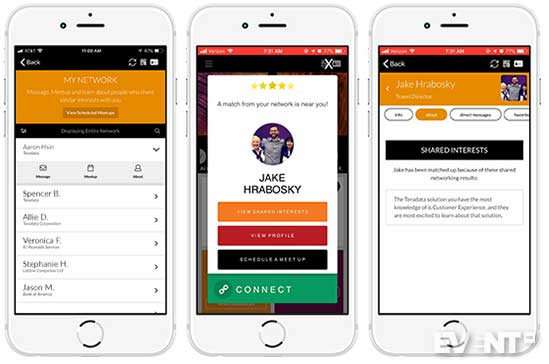

BEACON TECHNOLOGY ENABLED EASY CONNECTING
Proximity notifications alerted attendees when a match was nearby, shared profile information and conversation starters. Attendees didn’t have to search for a face in the crowd. This allowed attendees to interact naturally, anywhere at the event. For example, if an attendee was waiting by the elevator and a match was nearby, they would receive a notification and could strike up a conversation right then and there.
SCHEDULING MADE MEETINGS EASY
In order to ensure no one missed out on connecting with matches, attendees were given the option to easily schedule meetings with other attendees through “MyMeetups,” a scheduling system that displayed available time slots for both parties and allowed for a location selection at the event.
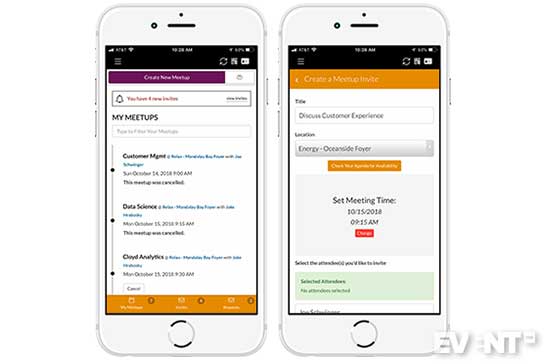

When the pop-up notifications alerted attendees when a match was nearby, and if an attendee viewed that match’s profile, they were given the option to schedule a meeting. This way, the attendee could focus on the event, and not have to think about the steps to take in the networking process.
GAMIFICATION DROVE DESIRED ATTENDEE ACTION
This was a natural fit for Vegas. Attendees were incentivized to complete tasks, like connecting with matches or sponsors/exhibitors. In all, there were 34 tasks that were a part of the gamification system. In order to encourage exhibitor connections, we weighted that task (connecting with an exhibitor) higher in terms of points awarded.
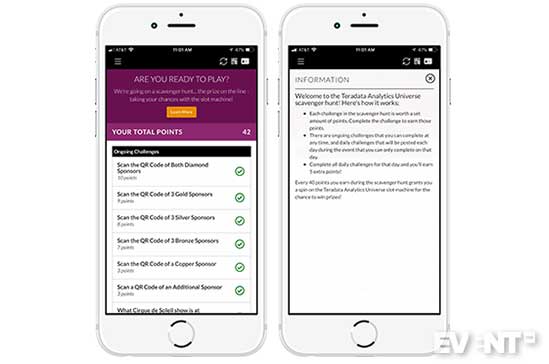

As attendees collected points, they were able to take a spin at a digital slot machine. To play the slot machines, attendees scanned their name badge at one of the live engagement displays, and rolling slots became visible. These displays are huge and attract a lot of attention. At the event, many people gathered around these displays, and they became a big conversation piece.
IN-APP VOTING UNITED THE AUDIENCE
In-app voting was used at the TUN 2018 Analytics & Data Challenge. Fifteen student finalists were selected to compete. A variety of case studies presented as poster sessions for data reports were shown throughout the event, and attendees used their app to digitally vote on these case studies.
The Results
Did the applied technology work in meeting Teradata’s objectives for its app? It sure did:
- Total App Users: 2139
- App Download: 92% (up 13%)
- Sessions per User: 13.87
- Pageviews per Session: 9.10
- Average Session Duration: 12 mins and 12 seconds
- Participants in Networking Challenge: 503
- 1:1 Meetings Scheduled Increased 450% YoY
- Social: 967 Slot Machine Spins, 3.2k Photos Posted
- Votes: 6,428 for the TUN Challenge
- Post Event Results: 89% Satisfied or Extremely Satisfied
MOST VISTED APP PAGES, RANKED:
- My Agenda: the personal agenda section tied directly to registration and in-app selections
- Scavenger Hunt: an event gamification
- General Agenda
- Attendee List: a carousel of attendees’ profiles that facilitates in-app and onsite networking (most activities utilized attendee profiles, which is why they saw a high number of page views)
- MyMeetups: a feature that allowed attendees to schedule 1:1 meetings with each other (another indication of plentiful networking)
- Expo Scanning- connecting with exhibitors
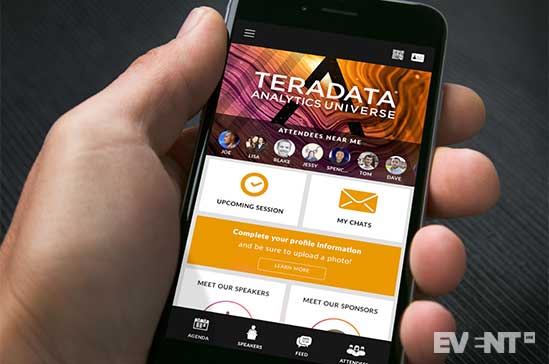

Ways to Ensure Your Tech Supports Your Event
The top takeaways for this event revolve around the proper use of technology. Features are great, but it’s how you incorporate their use and address concerns over user experience also matters.
Reward often.
Very few people are motivated by marathons. Short wins are more motivating than long, drawn-out goals. This is true of life and when using a motivational vehicle, like gamification, during an event. In order for gamification to be its most effective, you want to hook users with the feeling of winning or leveling up early.
This builds confidence and interest in the contest. Offering an ‘all or nothing’ prize can be discouraging for many. When attendees see a leaderboard with a leader unsurpassably far ahead of them, it can causes them to give up as they feel there’s no way they can compete. MeetingPlay used this technique with Teradata Analytics Universe, and attendees reacted favorably; small wins inspired the desired action.
Provide easy to view lists or personalized agendas for better decision making.
Give attendees the ability to select multiple sessions at the same time and then review/compare all choices to narrow down the list. You can do this through a personal agenda section, where attendees would be able to view all session options and make decisions on which sessions to choose. Providing this clear view of options provides the ability to make easier decisions.
Reduce friction for greater adoption and app use.
Don’t put too many hurdles in front of users. MeetingPlay always uses the same login for the registration system and the mobile app. Using two-way integration ensured all touch points were synched and all data was accurate across all systems. It also meant less friction for the user, which increased their likelihood of adopting and using the app.
IN CONCLUSION
An event app should be more than an electronic agenda. When integrated tightly into the event, it can increase participation in a desired activity, drive adoption, and produce actionable, real-time data. With well-suited technology, planners can use the data collected to improve offerings, personalize learning, engage attendees, and make networking more effective and fun.
Yet, this can only be done by:
- Considering the audience’s interests and familiarity with tech
- Understanding the goals of the event and how the tech can be used to meet them
- Removing the friction from participation
By following these suggestions, you’ll find and launch the right event app for your event and audience.

